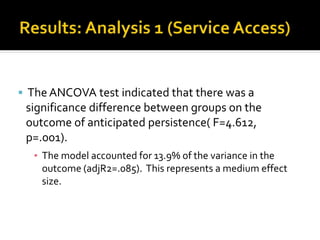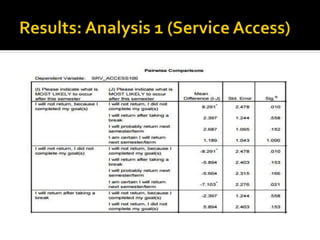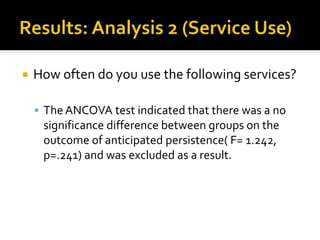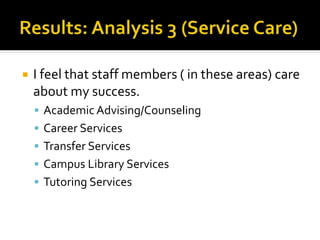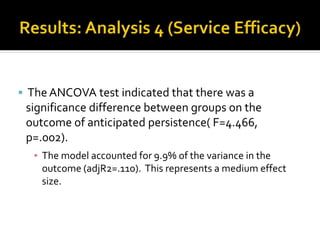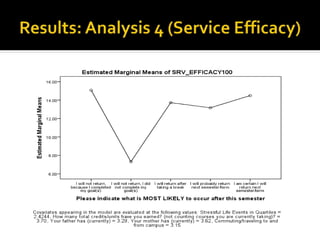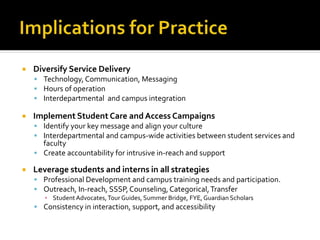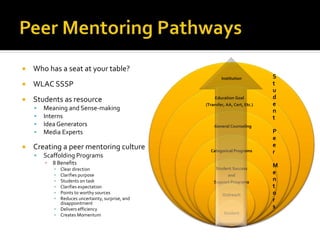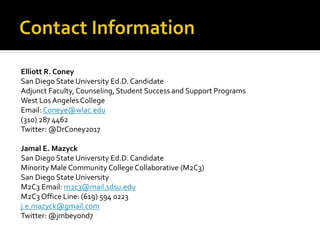This document summarizes a presentation on examining the relationship between institutional services and the anticipated persistence of African American male community college students. It discusses the study's purpose, methodology, theoretical framework, findings, and recommendations. The study found that students who did not intend to return had lower scores on measures of service access, care, and efficacy compared to other groups. This suggests negative student service experiences contribute to early departure. The presentation recommends diversifying service delivery, implementing student care campaigns, and leveraging peer mentoring and students as resources to improve services and outcomes for African American male students.
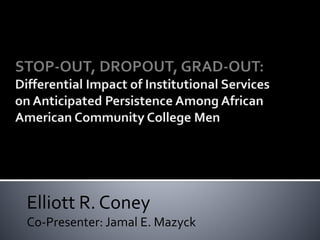



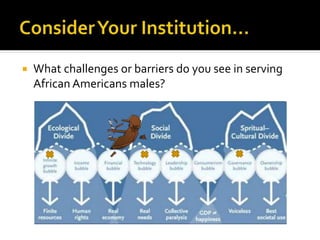


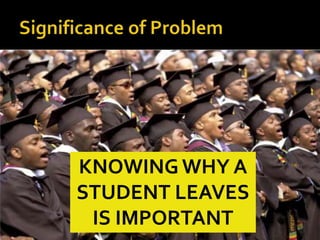





![Student Success
* Persistence * Achievement
* Attainment * Transfer * Goal
Accomplishment *Labor Market
Academic Domain
• Faculty-Student Interaction
• Academic Service Use
• Commitment to Course of Study
Campus Ethos Domain
• Sense of Belonging (Student-Student) (Student-
Faculty) (Student-Student Service)
• Campus Racial/Gender Climate
• Welcomeness to Engage
• Campus Resources (Access) (Efficacy)
• Internal Validating Agents (Faculty) (Staff)
Societal Factors
• Stereotypes
• Prejudice
• Criminalization
• Economic
Conditions
• Capital Identity
Projection
• Mass Incarceration
Background/
Defining
Factors
• Age
• Time Status
• Veteran Status
• Primary Language
• Citizenship Status
• Generation Status
• [Dis]ability
Environmental Domain
• Mediators (Finances) (Transportation) (External
Validating Agents)
• Commitments (Family Responsibilities)
(Employment)
• Stressful Life Events
Non-Cognitive Domain
• Intrapersonal (Self-Efficacy) (Locus of Control)
(Degree Utility) (Action Control) (Intrinsic
Interest)
• Identity (Gender) x (Racial/Ethnic) x (Spiritual)
x (Sexual)
Inputs Socio-Ecological Domains Outcomes
Socio-Ecological Outcomes (SEO) Model](https://image.slidesharecdn.com/58ba1484-bce0-406e-94ce-06457637e516-160316182318/85/A2Mend-Presentation-STOP-OUT-FINAL-14-320.jpg)


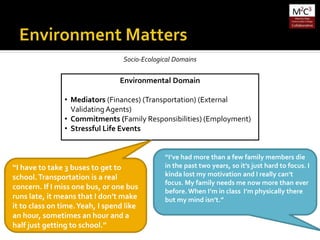
![Campus Ethos Domain
• Sense of Belonging (Student-Student) (Student-
Faculty) (Student-Student Service)
• Campus Racial/Gender Climate
• Welcomeness to Engage
• Campus Resources (Access) (Efficacy)
• InternalValidating Agents (Faculty) (Staff)
Socio-Ecological Domains
“[They communicate] do not take this class, at all.
Don’t even try to take this class.The professor
emphasized multiple times that if you’re not
getting it, drop the class. No ways on how I could
fix or improve. Just drop the class.”
“There are some teachers
that will tell you,. “I’ve
probably given just oneA in
the last 3 years.”That’s
bulls^!t. Because you even
get to class you know you
can’t get an A.”](https://image.slidesharecdn.com/58ba1484-bce0-406e-94ce-06457637e516-160316182318/85/A2Mend-Presentation-STOP-OUT-FINAL-18-320.jpg)



